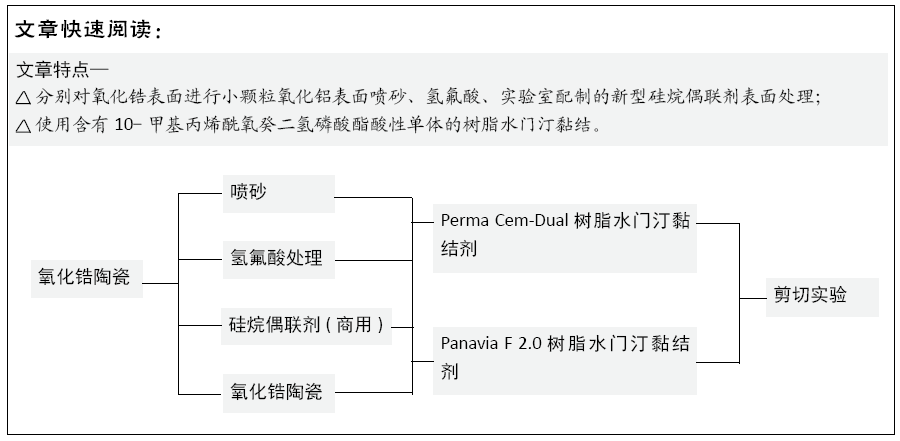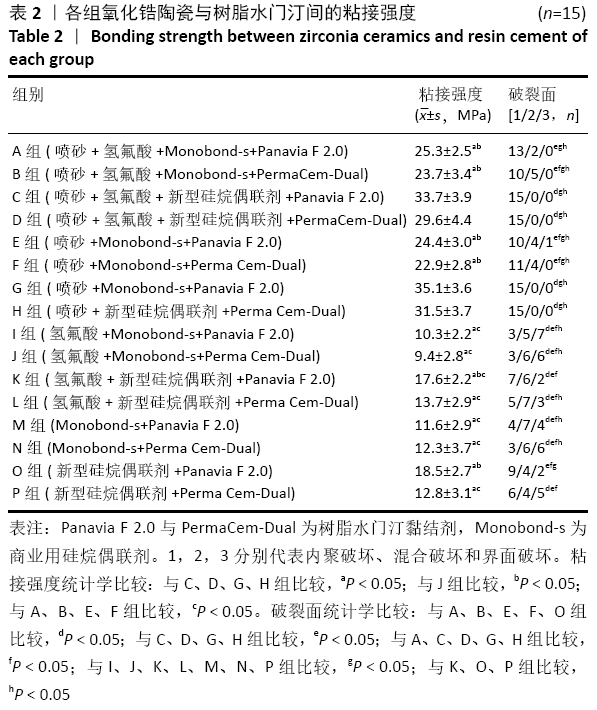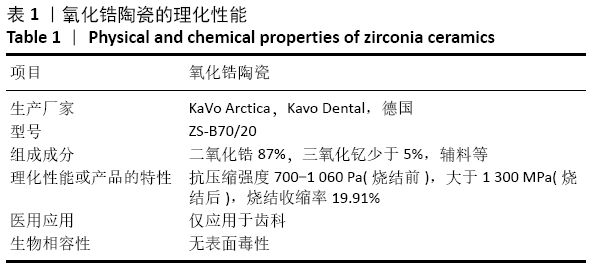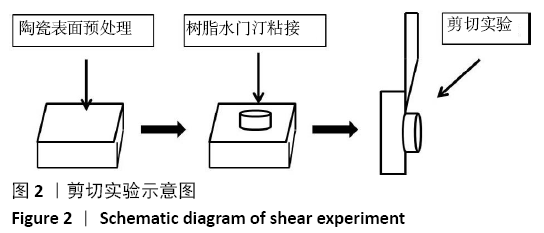[1] ZHANG Y, LAWN BR.Novel Zirconia Materials in Dentistry.J Dent Res.2018; 97(2):140-147.
[2] PIERALLI S, KOHAL RJ, JUNG RE, et al. Clinical outcomes of zirconia dental implants:a systematic review.J Dent Res.2017;96(1):38-46.
[3] DOS SANTOS RA, DE LIMA EA, MENDONÇA LS, et al. Can universal adhesive systems bond to zirconia?J Esthet Restor Dent.2019;31(6):589-594.
[4] LE M, LARSSON C, PAPIA E. Bond strength between MDP-based cement and translucent zirconia.Dent Mater J.2019;38(3):480-489.
[5] SULAIMAN TA, ABDULMAJEED AA, SHAHRAMIAN K, et al. Effect of different treatments on the flexural strength of fully versus partially stabilized monolithic zirconia.J Prosthet Dent 2017;118:216-220.
[6] YOSHIDA K. Influence of alumina air-abrasion for highly translucent partially stabilized zirconia on flexural strength, surface properties, and bond strength of resin cement.J Appl Oral Sci.2020;28:e20190371.
[7] OKADA M, TAKETA H, TORII Y, et al. Optimal sandblasting conditions for conventional-type yttria-stablized tetragonal zirconia polycrystals.Dent Mater. 2019;35(1):169-175.
[8] UWALAKA CO, KARPUKHINA N, CAO X, et al. Effect of sandblasting, etching and resin bonding on the flexural strength/bonding of novel glass-ceramics.Dent Mater.2018;34(10):1566-1577.
[9] INOKOSHI M, SHIMIZU H, NOSAKI K, et al. Crystallographic and morphological analysis of sandblasted highly translucent dental zirconia.Dent Mater.2018;34(3):508-518.
[10] ZHANG Y, SUN T, LIU R, et al. An in vitro evaluation of the zirconia surface treatment by mesoporous zirconia coating on its bonding to resin cement.Biomed Mater Eng.2014;24:2109-2116.
[11] MCLAREN EA, LAWSON N, CHOI J, et al. New high-translucent cubic-phase-containing zirconia: clinical and laboratory considerations and the effect of air abrasion on strength. Compend Cont Educat Denty.2017;38(6):e13-e16.
[12] POZZOBON JL, PEREIRA GK, WANDSCHER VF, et al. Mechanical behavior of yttria-stabilized tetragonal zirconia polycrystalline ceramic after different zirconia surface treatments. Mater Sci Engin.2017;77:828-835.
[13] ALAO AR, STOLL R, SONG XF, et al. Surface quality of yttria-stabilized tetragonal zirconia polycrystal in CAD/CAM milling, sintering, polishing and sandblasting processes.J Mech Behav Biomed Mater.2017;65:102-116.
[14] CHINTAPALLI R, MARRO F, PIQUE E, et al. Phase transformation and subsurface damage in 3Y-TZP after sandblasting.Dent Mater.2013;29:566-572.
[15] MENANI LR, FARHAT IA, TIOSSI R, et al. Effect of surface treatment on the bond strength between yttria partially stabilized zirconia ceramics and resin cement.J Prosthet Dent02014;112:357-364.
[16] LIMA RBW, BARRETO SC, ALFRISANY NM, et al. Effect of silane and MDP-based primers on physico-chemical properties of zirconia and its bond strength to resin cement.Dent Mater.2019;35(11):1557-1567.
[17] GO EJ, SHIN Y, PARK JW. Evaluation of the Microshear Bond Strength of MDP-containing and Non-MDP-containing Self-adhesive Resin Cement on Zirconia Restoration.Oper Dent.2019;44(4):379-385.
[18] MURAKAMI T, NSHIYAMA N, AIDA M. Effect of primer type on zirconia bonding performance.J Dent Mater.2017;36:41-48.
[19] PILO R, DIMITRIADI M, PALAGHIA A, et al. Effect of tribochemical treatments and silane reactivity on resin bonding to zirconia.Dent Mater.2018; 34(2): 306-316.
[20] RANJBAR OMIDI B, KARIMI YEGANEH P, OVEISI S,et al. Comparison of Micro-Shear Bond Strength of Resin Cement to Zirconia With Different Surface Treatments Using Universal Adhesive and Zirconia Primer.J Lasers Med Sci. 2018;9(3):200-206.
[21] MATINLINNA J, LASSILA L, ÖZCAN M, et al. An introduction to silanes and their clinical applications in dentistry.Int J Prosthodont.2004;17(2):155-164.
[22] LI R, MA SQ, ZANG CC, et al. Enhanced bonding strength between lithium disilicate ceramics and resin cement by multiple surface treatments after thermal cycling.PLoS One.2019;25;14(7):e0220466.
[23] LI R, SUN Y C, GAO P. The effects of the macroscopic conditions of a ceramic primer with high bond durability in a silica-based ceramic.Mater Res Innovat. 2015;19(sup5):S5-1280-1284.
[24] BALKAYA H, DEMIRBUGA S, ÇAKIR NN, et al. Micro-shear bond strength of universal adhesives used for amalgam repair with or without Alloy Primer.J Conserv Dent.2018;21(3):274.
[25] KHAN AA, MOHAMED BA, AL-HIJJI SM, et al. Influence of Aging Time and Medium on Enclosed Mold Shear Bond Strength on Titanium.Mater Exp. 2019;9(2):159-165.
[26] KERN M, WEGNER SM. Bonding to zirconia ceramic: adhesion methods and their durability.Dent Mater. 1998;14(1):64-71.
[27] MILLER JD, KAI HH, ISHIDA H. Studies of the simulation of silane coupling agent structures on particulate fillers: The pH effect.Polym Composite. 1984;5(1):18-28.
[28] NISHIYAMA N, SHICK R, ISHIDA H. Adsorption Behaviour of a Silane Coupling Agent on Colloidal Silica Studied by Gel Permeation Chromatography.J Colloid Interf Sci.1991;143(1):146-156.
[29] LI R, SUN YC, WANG C, et al. Bonding of an opaque resin to silane-treated porcelain. Biomed Mater Eng.2014;24(6):2117-2125.
[30] LI R, ZHOU H, WEI W, et al. Effects of Mechanical and Chemical Pretreatments of Zirconia or Fiber Posts on Resin Cement Bonding.PLoS One. 2015;10(6):e0129690.
[31] LI R. Development of a ceramic primer with higher bond durability for resin cement. J Oral Rehabil.2010;37(7):560-568.
[32] 李睿,王晨,孙迎春.不同酸性水解催化液对硅基质陶瓷与树脂粘接效果的影响[J].中华口腔医学杂志,2012,46(11):692-695.
|




